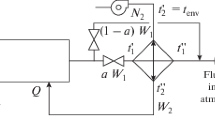Abstract
Strictly speaking, the common two-fluid heat exchanger is a special version of a three-fluid exchanger because the environment also participates in the energy exchange. In a number of situations this effect is significant and leads to either reduced or increased area requirements, depending on the purpose of the exchange operation. With certain combinations of the system parameters it is even impossible to achieve an envisaged temperature change. For some typical flow arrangements these combinations are established in an analytic form so that one can rapidly assess the feasibility of a desired process without actually performing the rather tedious design calculations.
Zusammenfassung
Wegen des grundsätzlich immer vorhandenen Wärmeaustausches mit der Umgebung ist der gewöhnliche Zweistoff-Wärmeaustauscher als Sonderform des Dreistoff-Wärmeaustauschers aufzufassen. In zahlreichen Situationen führt der Umgebungseinfluß zu merklich vergrößerten oder reduzierten Austauschflächen, je nach dem Zweck des Prozesses. Darüberhinaus läßt sich eine gewünschte Temperaturänderung unter gewissen Bedingungen überhaupt nicht mehr erreichen. Für einige typische Stromführungen werden diese Bedingungen hergeleitet; damit kann man direkt und ohne größeren Rechenaufwand feststellen, ob und für welche Parameterkombinationen ein angestrebter Austauschprozess realisierbar ist.
Similar content being viewed by others
Abbreviations
- cp :
-
specific heat capacity, Jkg−1K−1
- m:
-
mass flow-rate, kg s−1
- r:
-
tube radius, m
- T:
-
temperature, K
- Ui,0 :
-
overall heat-transfer coefficient between two fluids, Wm−2K−1
- z:
-
axial length coordinate of heat exchanger, m Dimensionless quantities
- B1,2,C1,2D1,2 :
-
coefficients defined by Eqs. (9) to (11)
- C=mi cpi/(m0cp0 :
-
ratio of heat capacity rates
- U=r0U0/(riUi):
-
ratio of weighted transfer coefficients
- Δ=(T01-Ta)/(T01-Ti1):
-
characteristic temperature ratio
- ζ:
-
axial length coordinate of heat exchanger
- a:
-
surroundings
- i:
-
tube-side
- 0:
-
shell-side
- 1:
-
inlet of tube-side fluid
- 2:
-
outlet of tube-side fluid
- *:
-
at temperature extremum
References
K. Nesselmann: Der Einfluß der Wärmeverluste auf Doppelrohrwärmeaustauscher, Z. ges. Kälteindustrie,35 (1928) 62/67
J. Kern: Heat transfer in a rotary heat exchanger. Int. J. Heat Mass Transfer.17 (1974) 981/990
J. Wolf: General solution of the equations of parallel-flow multichannel heat exchangers, Int. J. Heat Mass Transfer7 (1964) 901/919
J.C. Chato; R.C. Laverman; J.M. Shah: Analysis of parallel flow, multi-stream heat exchangers, Int. J. Heat Mass Transfer14 (1971) 1691/1703
D.D. Aulds; R.F. Barron: Three-fluid heat exchanger effectiveness. Int. J. Heat Mass Transfer10 (1967) 1457/1462
H. Hausen: Wärmeübertragung im Gegenstrom, Gleichstrom und Kreuzstrom. Berlin: Springer (1950)
Author information
Authors and Affiliations
Rights and permissions
About this article
Cite this article
Kern, J. On the feasibility of heat-exchange processes in uninsulated equipment. Wärme- und Stoffübertragung 9, 267–272 (1976). https://doi.org/10.1007/BF01003578
Received:
Issue Date:
DOI: https://doi.org/10.1007/BF01003578



